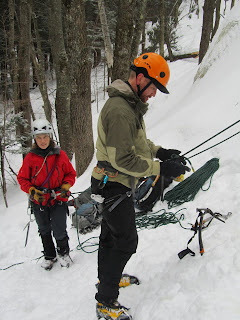You know that feeling: you've had it up to here, you're frustrated, tired, you've psyched yourself out of a new challenge, you've decided you just can't do it. We've all been there (some of us more than we care to admit). It's enough to put a good-sized dent in your ego, large enough to let the doubts creep in. "Maybe I'm not cut out for this!" Time to give up, pack it in, and then that glum feeling of not being good enough to tackle the challenge is all-consuming for me. It literally ruins my night, and sometimes taints my emotions the next day, too.
Those feelings in that moment are telling you to take a break. Come back to it later. Let it rest in your subconscious, whatever mental or physical obstacle is in your path, just let it sit there for a while--a day, a week, whatever it takes. But come back to it when you're more relaxed. Chances are, you've worked through the issues in your brain, and now you are ready to accept that challenge and conquer it.
For the chick who has always relished a scholastic challenge, all these new activity-related challenges are forcing me to take another look at how I handle obstacles I'm unaccustomed to facing. And, sad to say, I have found that I tend to act like a child, throwing a minor tantrum. I whine. I stomp around. I huff. "It's not fair!" Ugh, give me a break, little girl. Grow up already!
So I took a step back on three new activities: a particularly challenging route on a climbing wall that I attempted numerous times, only to run out of arm strength while stuck and then fell each time after saying "I can't do it, I give up!"; a tough spin on the pole (previous attempts of which left me slightly bruised and bloodied and ready to quit the class altogether); and baking sourdough bread.
A motley crew, that list.
Two weeks were all I needed. For two weeks, I completely forgot about the climbing. Didn't think about it at all. When I returned, I had a whole new perspective and was ready to use a different technique to conquer that route. I needed space before I was ready to meet that obstacle head-on.
For two weeks, I went over and over and over in my head the exact way I would enter into the pole spin, my leg positioning, I imagined the feel of the momentum and mentally practiced the routine. I came back to the class and managed to get through about a dozen not-half-bad spins that were slightly more graceful than previous attempts. For this challenge, I needed to prepare for it and build up the confidence needed to pull it off successfully.
The bread...that's another story. Since my first successful batch, I've attempted two newer batches that have failed during the rise. They just fell apart and turned all soupy and the yeast lost its elasticity. I tried warmer conditions, cooler conditions, plastic wrap, more rest time. Nothing seemed to work. Bread: 2, Becky: 1. Sourdough yeast is a tough competitor and is definitely not on the home team. I'm not ready to give up entirely, but I need some breathing space on this one before I can come back and tackle this again.
As an aside, I'm diving back into my banjo practice, starting from scratch with lessons from a new teacher. I have a feeling I'll need to put this newly acquired knowledge about myself to work for my music practices as well.
Wednesday, March 30, 2011
Thursday, March 10, 2011
The balancing act
 Tucked away behind North Conway, N.H., Cathedral Ledge rises dramatically above its hemlock and white pine neighbors with steep rock ledges. With rock climbing during the summer, ice climbing in winter, this spot is so popular that you might wait a while for your turn to climb.
Tucked away behind North Conway, N.H., Cathedral Ledge rises dramatically above its hemlock and white pine neighbors with steep rock ledges. With rock climbing during the summer, ice climbing in winter, this spot is so popular that you might wait a while for your turn to climb.It took me one year to gather my courage and commit to ice climbing. I wanted to attempt it last year, but chickened out. This year, I purchased two spots in an EMS class, Intro to Winter Climbing (learning the basics of ice climbing and mountaineering) for the man's birthday. I packed a bag full of clothing layers and food. I like to be warm and well-fed, obviously.
After being fitted for our technical gear at the EMS store in town (gear including mountaineering boots, harness, belay device, carabiners, helmets, ice axe, mountaineering axe, crampons), we headed to the ledge for our day-long lesson.
Bulges of yellow and white snow-packed ice awaited, divots from previous climbers showing us the thicker ice to climb and avoid the thinly covered rocks that are the real gear-killers. Snow still lightly covered the hemlock needles, creating a cheery winter scene despite the light misting drizzle that started.
 Our lesson began first with learning to climb in boots that do not allow your ankles to flex, a task tougher than you might think. Duck walk (inner arches pointed forward), French technique (sideways walking uphill), and International technique (front foot jammed straight into hill using crampons, back foot sideways with inner arch pointed uphill) allowed us to get to the ice slabs, layers and layers of ice either attached to rocks or acting as a pillar between rocks. Some of it brittle, some of it strong, we would learn by experience how trustworthy the ice--and our technique--would be. And so we began, with our awesome instructor Sara at the helm.
Our lesson began first with learning to climb in boots that do not allow your ankles to flex, a task tougher than you might think. Duck walk (inner arches pointed forward), French technique (sideways walking uphill), and International technique (front foot jammed straight into hill using crampons, back foot sideways with inner arch pointed uphill) allowed us to get to the ice slabs, layers and layers of ice either attached to rocks or acting as a pillar between rocks. Some of it brittle, some of it strong, we would learn by experience how trustworthy the ice--and our technique--would be. And so we began, with our awesome instructor Sara at the helm. The thing about ice climbing is this: it's really a balancing act more than anything. The gear does most of the work. Sure, you are in charge of ensuring the front of your crampons are securely gripping into the ice for adequate footing. Yes, the axe must be hooked into the ice properly. But you don't need to be in fabulous physical shape to climb. You just need to be well-balanced--ice axe above head, legs spread to form a triangle between the axe and your feet. Swing the pick, kick toes into ice, push up. Repeat.
The thing about ice climbing is this: it's really a balancing act more than anything. The gear does most of the work. Sure, you are in charge of ensuring the front of your crampons are securely gripping into the ice for adequate footing. Yes, the axe must be hooked into the ice properly. But you don't need to be in fabulous physical shape to climb. You just need to be well-balanced--ice axe above head, legs spread to form a triangle between the axe and your feet. Swing the pick, kick toes into ice, push up. Repeat. Thanks to my recent indoor climbing sessions, I've become accustomed to trusting the harness and climbing gear to catch me if I fall. I am now able to look down and around while climbing without any ounce of panic, which is a gigantic step forward for me in conquering my intense fear of heights. This was a fabulous advantage for ice climbing, where the stark beauty of the icy landscape surrounding you is a mental image you'll want to carry with you forever.
Thanks to my recent indoor climbing sessions, I've become accustomed to trusting the harness and climbing gear to catch me if I fall. I am now able to look down and around while climbing without any ounce of panic, which is a gigantic step forward for me in conquering my intense fear of heights. This was a fabulous advantage for ice climbing, where the stark beauty of the icy landscape surrounding you is a mental image you'll want to carry with you forever. I'm not saying it wasn't physically and mentally challenging--it most definitely was both. But for our first time, it wasn't as scary as I thought it would be, and even when I got frustrated, I was still having fun.
I'm not saying it wasn't physically and mentally challenging--it most definitely was both. But for our first time, it wasn't as scary as I thought it would be, and even when I got frustrated, I was still having fun.We ended our lesson with self-arrest techniques to stop ourselves from sliding down a hill and over a cliff in the snow, an extremely important bit of knowledge for winter activities. Once we shed our gear, the man and I headed to Cranmore Mountain for some more fun on the mountain coaster and snow tubing. Hard work should always be followed up by hard play.
Subscribe to:
Comments (Atom)
